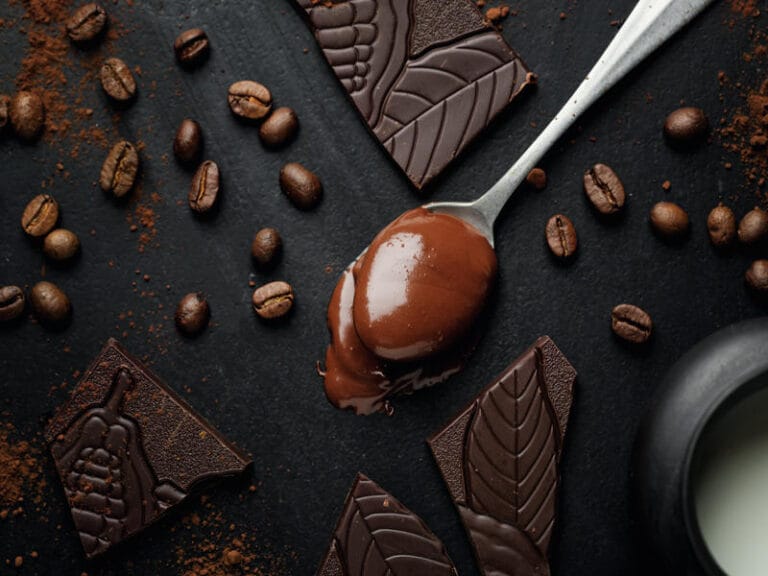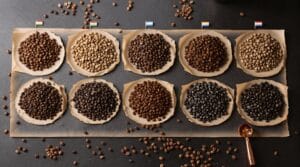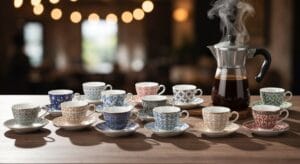Mocha combines coffee, chocolate, and milk for a caffeinated drink that’s rich yet balanced. It relies on espresso’s bold, roasted kick, melted or powdered chocolate for sweetness, and steamed milk for creaminess. Pure chocolate, meanwhile, skips coffee entirely, using cocoa solids (for deep flavor), sugar (for sweetness), and sometimes milk (for smoothness) to create its velvety texture. Both share cocoa magic, but mocha adds a jolt. Want to dig deeper? Surprises await…
Essential Ingredients: Coffee, Milk, and Chocolate in Mocha
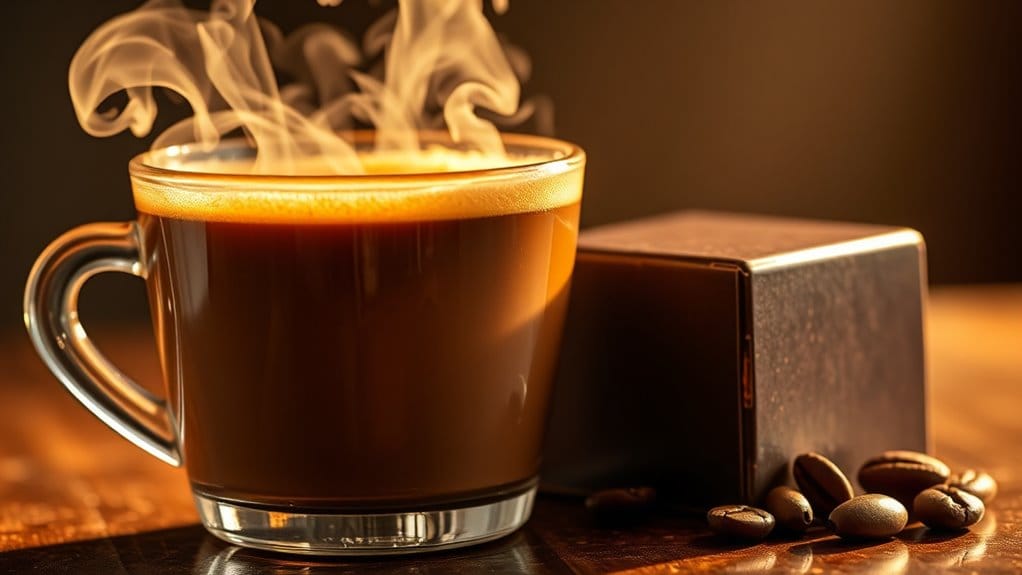
Mocha’s magic comes from a trio of ingredients working like a dream team: coffee, milk, and chocolate. The name “mocha” nods to Al Moka, Yemen, the historical coffee port that lent its name to beans with natural chocolatey notes. Unlike hot chocolate, which skips the coffee, a mocha blends espresso’s bold kick with steamed milk’s creaminess, all tied together by chocolate’s sweet charm. This rich combination of flavors harks back to the beverage’s origin in Yemeni coffee known for its intense chocolate flavor profile. Moreover, the use of immersion brewing techniques, such as French Press or AeroPress, can enhance the coffee’s chocolatey notes while ensuring a bolder flavor extraction.
The coffee isn’t just brewed—it’s *espresso*, made by forcing hot water through finely ground beans, delivering about 63 mg of caffeine per shot (more if you use lighter roasts!). Milk, steamed to 150–160°F, turns velvety smooth, while chocolate sneaks in as syrup, powder, or melted bars.
Mix these just right, and coffee takes the lead, with chocolate as its hype crew. That’s the key difference between mocha and chocolate: one’s a caffeinated power trio, the other’s a cozy cocoa solo act. Choose your adventure!
Chocolate Composition: Cocoa, Sugar, and Milk Solids

Chocolate, that glorious treat we all love, isn’t just magic—it’s science! Cocoa solids—the powdery stuff from roasted beans—give chocolate its deep flavor, with dark types packing 35-85% cocoa for bold, bitter kicks and milk versions using just 10-30% for mellowness. But don’t forget cocoa butter—the natural fat from cacao beans making up over half of each bean—that’s responsible for chocolate’s silky texture and melt-in-your-mouth feel.
Sugar swoops in to balance bitterness, hiding in dark bars (10-55%) and dominating milk ones (40-50%), doubling as texture wizard for smooth melts.
Then there’s milk solids—powdered or condensed milk—adding creaminess to milk chocolate (12-25%), like Swiss bars luxuriating in extra dairy.
Together, these trio ingredients tango: cocoa shouts intensity, sugar sweetens the deal, milk softens the edges.
Want nutrients? Cocoa’s flavanols bring antioxidants, but milk and sugar dilute them.
Every bite? A tasty experiment!
Caffeine Differences: Espresso vs. Cocoa Content
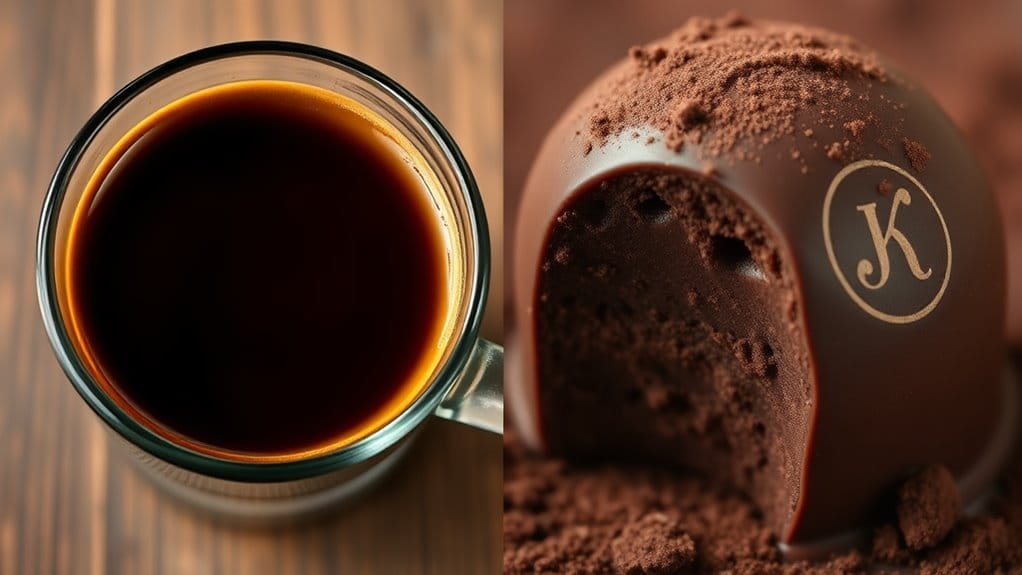
Mocha Vs Chocolate: What Ingredients Make Each Unique?
Caffeine Differences: Espresso vs. Cocoa Content
While chocolate’s mix of cocoa, sugar, and milk makes it creamy and sweet, its caffeine content gets upstaged by espresso’s punch. A single shot of espresso packs roughly 63–75 mg of caffeine—nearly six times more than cocoa powder, which holds a measly 12 mg per tablespoon. Robusta beans, known for their higher caffeine content, can yield significantly more than their Arabica counterparts.
Dark chocolate adds a little zing, but espresso’s power comes from variables like bean type (Robusta vs. Arabica), roast level, grind size, and how tightly it’s packed. Even “weak” espresso outpaces chocolate!
A mocha, blending both worlds, stacks caffeine from espresso and dark chocolate, hitting 90–180 mg per drink. Health experts caution that exceeding the daily limit of 400 mg can trigger anxiety and sleep disruptions, so moderation matters. So, if you crave energy, espresso’s the MVP—though cocoa’s sneaky caffeine might tip you into “who needs sleep?” territory.
Choose beans wisely, though: lighter roasts, fine grinds, and robusta beans mean bigger buzz!
Flavor Profiles: Balancing Coffee and Chocolate Notes
Imagine a dance party where espresso and chocolate groove together, one bold and bitter, the other sweet and smooth, creating that magic mocha harmony! Mocha’s dark chocolate (70%+ cocoa) adds rich, complex flavors that match espresso’s bold kick, while steamed milk steps in as the milky peacekeeper, softening sharp edges into creamy bliss. Arabica coffee’s cultivation requirements help nurture the flavor profile that complements the chocolate’s richness. Chocolate types flip the script: dark brings depth, semisweet balances bitterness, and milk chocolate leans sugary. Pure chocolate drinks, though, skip the coffee, making cocoa the solo star—no bitter backup dancer! The synergy between the coffee’s growing conditions and the chocolate’s origins roots them both in a shared heritage that enhances their flavors.
| Aspect | Mocha | Pure Chocolate |
|---|---|---|
| Flavor Balance | Espresso-chocolate tango | Cocoa takes center stage |
| Texture | Velvety, milk-smoothed | Silky or dense, no foam |
| Sweetness | Bitter-sweet equilibrium | Chocolate-driven, no coffee |
Shared earthy roots from coffee and cacao beans let mocha’s flavors click like long-lost cousins, turning every sip into a bean-born reunion!
Frequently Asked Questions
Is Mocha Named After a Specific Geographic Location?
Mocha originated from Al Mokha, a historic Yemeni port city central to the global coffee trade. The term evolved to describe both its signature beans and beverages combining coffee and chocolate flavors, reflecting its geographic roots.
Why Does Starbucks Label Some Drinks as Mocha Without Espresso?
Starbucks labels drinks as mocha when they include its mocha sauce, focusing on chocolate flavor rather than espresso. Customization allows espresso omission, catering to preferences for caffeine-free, mild coffee experiences while retaining the chocolate-centric name.
Can Mocha Drinks Be Made With Dairy-Free Chocolate Alternatives?
Dairy-free chocolates (almond, coconut, oat) can replace traditional options in mochas. Substitutions alter flavor and texture; adjustments with plant milks or cocoa products maintain coffee-chocolate balance, though allergen considerations may apply based on alternative ingredients used.
Are Mochas Considered Chocolate Beverages or Coffee Beverages?
A mocha, blending domains like a bridge, marries espresso’s boldness with chocolate’s sweetness—its coffee foundation anchors it as a caffeine-crafted drink. Despite shared cocoa notes, the espresso pulse defines it as a coffee beverage.
Do Mochas Have Health Benefits From Both Coffee and Chocolate?
Mochas combine coffee’s antioxidants with cocoa’s flavonoids, potentially amplifying cognitive and cardiovascular benefits. However, added sugars or high-calorie chocolate variants may offset advantages, depending on preparation methods and ingredient proportions.
References
- https://gospecialtycoffee.com/ckb/types-of-coffee-drinks/mocha/
- https://www.surlatable.com/milk-chocolate-mocha/REC-241751.html
- https://www.javapresse.com/blogs/enjoying-coffee/mocha-mastery-the-only-guide-youll-ever-need-for-perfect-mocha
- https://www.homeofcoffee.com/products/cafe-essentials-milk-chocolate-mocha
- https://www.allrecipes.com/recipe/23538/mocha-coffee/
- https://www.coracaoconfections.com/blogs/news/chocolate-what-is-it-made-of
- https://www.cocoterra.com/what-does-the-cocoa-on-chocolate-packaging-really-mean/
- https://beantobarworld.com/bean-to-bar-blog/understanding-ingredients-in-chocolate
- https://hameschocolates.co.uk/Resources/chocolate-blog/what-exactly-do-cocoa-solids-percentages-mean-on-chocolate-ingredients-labels
- https://wildwestchocolate.com/blogs/news/50-75-80-what-does-cocoa-percentage-mean

